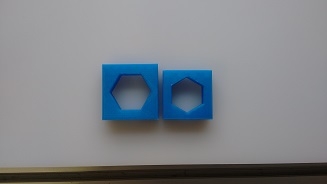Here is the program I used for the demonstration:
Program
Robot Program
MoveJ
Waypoint_1
Gripper Open
Camera Locate
MoveL
Waypoint_6
Waypoint_5
Gripper Close
Waypoint_7
If rq_current_pos()≥85 and rq_current_pos()≤95
MoveL
Waypoint_2
Waypoint_3
Gripper Open
Waypoint_4
If rq_current_pos()≥100 and rq_current_pos()≤110
MoveL
Waypoint_8
Waypoint_9
Gripper Open
Waypoint_10

The Dof Community was shut down in June 2023. This is a read-only archive.
If you have questions about Robotiq products please reach our support team.
If you have questions about Robotiq products please reach our support team.
 Tyler_Berryman
Tyler_Berryman
 K_Bing
K_Bing
 Annick_Mottard
Annick_Mottard
Hi all,

I curious to see how sensitive the Robotiq camera was to a variation in the dimensions of a part that was taught to the vision system. So I 3D printed two parts that have the same geometry, but the dimensions are slightly different. The first part is 2.25"x2.25", whereas the second part is 2"x2". The following picture illustrates the small difference between these two parts.
As you can see, the parts are very similar. I taught the larger part to the vision system using a yellow background. I tested the difference between the detection scores, the larger object(The object taught to the vision system) I was getting a detection score of about 82%, and I was getting a detection score of roughly 65% for the smaller part. So I could have used the detection threshold to differentiate these parts, but I would've had to use a second camera locate node to find the smaller part. So I decided to work with a detection threshold of 60% to be able to identify both parts using the same camera locate node. I decided to use the gripper's function " rq_current_position" to get feedback from the gripper regarding the position of the fingertips. When gripping the larger part, I was getting a position value of 89, and I was getting a value of 105 for the larger part. Knowing this I simply used two if statements to place these parts into two different bins.
Here is a video of the demonstration:
https://youtu.be/woXJo0CPUe0